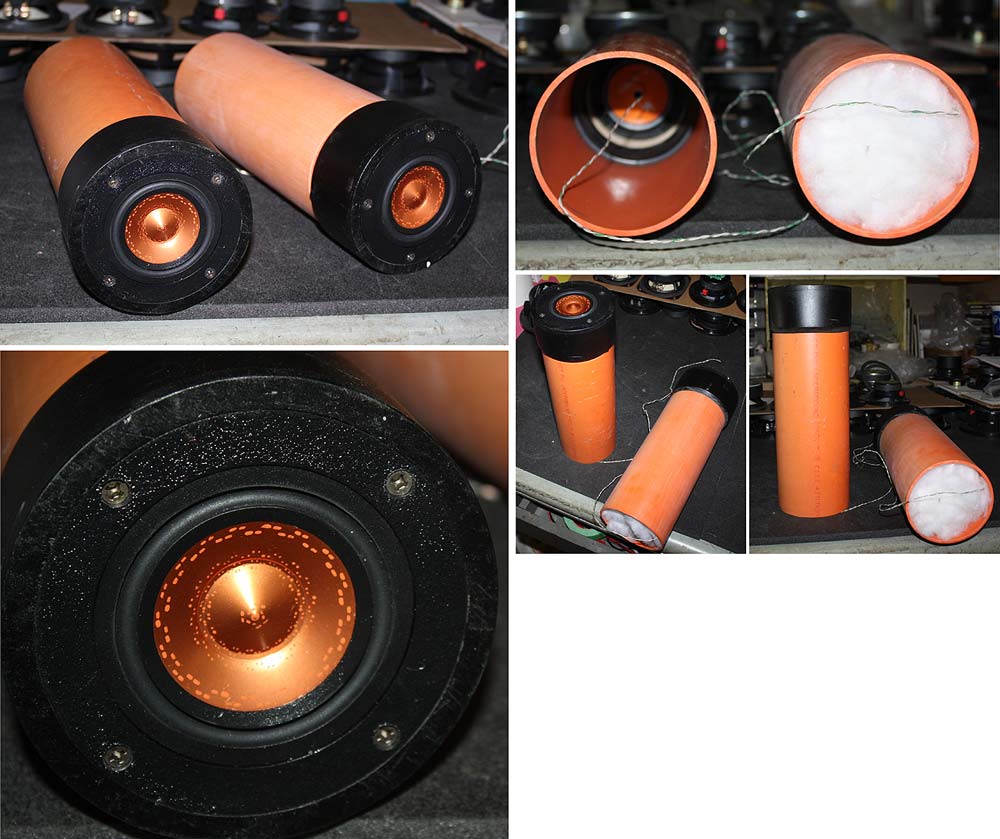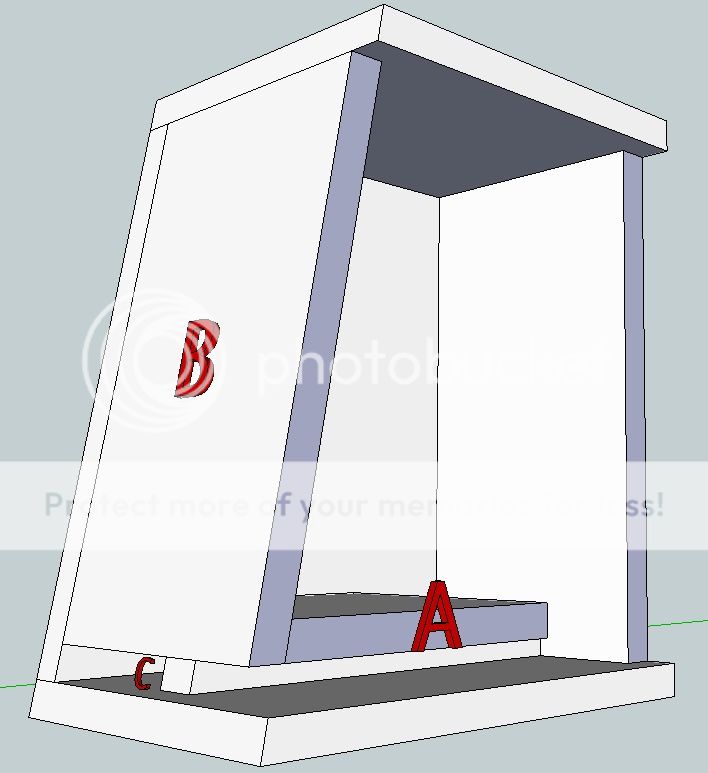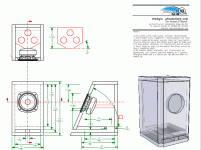Guys
Due to their shallow depth I'm considering building a pair of these for near field desktop use.
Now these look to employ a pair of Tang Band W4-1320SIF. But for the life of me I can't find out the manufacturers recommended enclosure volume. Can anyone help me with this? Also, should they be ported or sealed?
Also, as a design challenge I was considering concrete as a material, or 19mm ply sandwiched together. Anyone care to comment on the material choice?
Now I've considered the mHonkens and have built three of Dave's designs which I love. This time I'm looking for something visually different for my computer speakers. More of a design statement, but with solid audio performance.
Thoughts?
Elliott
Due to their shallow depth I'm considering building a pair of these for near field desktop use.
Now these look to employ a pair of Tang Band W4-1320SIF. But for the life of me I can't find out the manufacturers recommended enclosure volume. Can anyone help me with this? Also, should they be ported or sealed?
Also, as a design challenge I was considering concrete as a material, or 19mm ply sandwiched together. Anyone care to comment on the material choice?
Now I've considered the mHonkens and have built three of Dave's designs which I love. This time I'm looking for something visually different for my computer speakers. More of a design statement, but with solid audio performance.
Thoughts?
Elliott
Interesting speakers.
I don't see much point in using anything beyond PVC pipe, or even thick cardboard tube for a speaker like this.
My 1st inclination would have the driver in the "box" you point to as a 3"/
I have a similar speaker that uses a standard PVC adapter with a fitted wooden ring with 4" PVC pipe that perfectly fits both an Alpair 5 and the big buck 3" Scan Speak 10F (only 2 drivers i have tried in it.

dae
I don't see much point in using anything beyond PVC pipe, or even thick cardboard tube for a speaker like this.
My 1st inclination would have the driver in the "box" you point to as a 3"/
I have a similar speaker that uses a standard PVC adapter with a fitted wooden ring with 4" PVC pipe that perfectly fits both an Alpair 5 and the big buck 3" Scan Speak 10F (only 2 drivers i have tried in it.

dae
Thanks Dave.
I see the volume of your tube speaker are significantly larger than that of the "Well Rounded" design. Part of their appeal to me was their shallow depth. In that they would sit either side of my laptop without taking too much space.
What drivers do you think would suit such a small enclosure?
Is concrete generally frowned upon for small speakers like this?
I see the volume of your tube speaker are significantly larger than that of the "Well Rounded" design. Part of their appeal to me was their shallow depth. In that they would sit either side of my laptop without taking too much space.
What drivers do you think would suit such a small enclosure?
Is concrete generally frowned upon for small speakers like this?
Thanks Dave.
I see the volume of your tube speaker are significantly larger than that of the "Well Rounded" design. Part of their appeal to me was their shallow depth. In that they would sit either side of my laptop without taking too much space.
What drivers do you think would suit such a small enclosure?
without hearing the Well Rounded, it'd be hard to say if the drivers used therein are achieving anywhere near their full potential - those are pretty teeny enclosures for sure
While a friendly debate could ensue if addressing the technical merits (or not) of using concrete or any high mass material for moveable speaker enclosures of any design (can you read between the lines on my thoughts on the subject?Is concrete generally frowned upon for small speakers like this?
So more than anything, I'd say it's the pain in the but-tocks factor that keeps more folks from trying it.
* see this old link to projects using off the shelf PVC / ABS plumbing pipe & parts
Laying Pipe with Audio Lego
As of the hour of this post, the links to thumbnail photos on the index page aren't working, but click on any of the individual project links for further details.
Laying Pipe with Audio Lego
As of the hour of this post, the links to thumbnail photos on the index page aren't working, but click on any of the individual project links for further details.
Fixed.
dave
Thanks Dave.
I see the volume of your tube speaker are significantly larger than that of the "Well Rounded" design. Part of their appeal to me was their shallow depth. In that they would sit either side of my laptop without taking too much space.
What drivers do you think would suit such a small enclosure?
Is concrete generally frowned upon for small speakers like this?
My cab is just an example, in this case a mid-TL, if i was using it FR i'd optimize the volume for sealed ot Vented box.
Alpair 6.2 (either) or FF85wk would be my 1st choice. Your pipe would need 2.5 litre. The 6M and FF85 can get away with less volume (down to say 1.5 litre -- in the case of the 6M the vent becomes so large that you might as well build the 2.5.
dave
I get the feeling they might be more "form" over "function" according to this review.
Oh well back to the drawing board.
Oh well back to the drawing board.
Dave
Hypothetically speaking, what would I need to do to make your mHonkens "active" like the Audioengine 2?
Is there a suitable "off the shelf" plate amp that would be small enough (both physically and in power) to fit. Removing the footprint of a desktop amp would make these very appealing.
Hypothetically speaking, what would I need to do to make your mHonkens "active" like the Audioengine 2?
Is there a suitable "off the shelf" plate amp that would be small enough (both physically and in power) to fit. Removing the footprint of a desktop amp would make these very appealing.
Audio Engine has 15 w rms. The following amps are rated higher but when operated at 15 w rms, will have pretty good low distortion values. You can power them with cheap 19 V laptop bricks.
Stick one of these in each cabinet: Kemo M034N 40 Watt Universal Mono Amplifier Module 320-554
Or one of these in one cabinet and connect two boxes with speaker cable: 2x25W @ 4 Ohm TDA7492 Class-D Audio Amplifier Board Only 320-332
Or if you had a two way you can even bi-amp with this: 4x100W @ 4 Ohm TK2050 Class-T Digital Audio Amplifier Board 320-302
Stick one of these in each cabinet: Kemo M034N 40 Watt Universal Mono Amplifier Module 320-554
Or one of these in one cabinet and connect two boxes with speaker cable: 2x25W @ 4 Ohm TDA7492 Class-D Audio Amplifier Board Only 320-332
Or if you had a two way you can even bi-amp with this: 4x100W @ 4 Ohm TK2050 Class-T Digital Audio Amplifier Board 320-302
Last edited:
Dave
Hypothetically speaking, what would I need to do to make your mHonkens "active" like the Audioengine 2
Technically the A2 is not an active speaker it is a powered speaker, there is still a passive XO.
What is an mHonken -- i searched my HD for such a thing, could not find anything. I recall having the name pass thru my head, but pretty sure i discarded it as inappropriate.
Any of these speakers could be powered by adding an amplifier. Do note that inside a loudspeaker is not a good place to put an amp.
dave
@MillicentBystander - Yorkie, Jack Terrier 2 are not designed to produce thunderous bass - on the contrary. They are designed to produce well defined upper bass registers and they do reach down to 90Hz where they integrate well with a good, fast sub. The advantage of this is much cleaner midband and cleaner treble as you don't pollute it with heavy bass. The review mentioned by you perfectly supports that and as you can read Yorkies can clearly recognize and take advantage from better amplification. Full range drivers are very transparent and will give you pretty good window into a recording and will show advantages and also disadvantages of ancillary equipment.
They will overload quickly if used in larger/ported enclosure and you will defeat their purpose - they are not designed to play 20Hz or heavy bass as their xmax is very limited.
You can perhaps experiment with transmission or horn loaded enclosures to get better bass and not overdrive the speaker driver but they might end up impractically large for a desktop use.
To build a pair - the 19mm ply is very good material option ( such as Corgi - which uses CNC milled ply ), concrete is also an excellent material and has great industrial look to it but it is much more difficult to work with and build a proper enclosure. One thing to note - WRS speakers use customized drivers that are matched. The stock drivers are not matched and you might end up with different sounding left and right channel if not paired/matched properly.
Cheers,
jerry
They will overload quickly if used in larger/ported enclosure and you will defeat their purpose - they are not designed to play 20Hz or heavy bass as their xmax is very limited.
You can perhaps experiment with transmission or horn loaded enclosures to get better bass and not overdrive the speaker driver but they might end up impractically large for a desktop use.
To build a pair - the 19mm ply is very good material option ( such as Corgi - which uses CNC milled ply ), concrete is also an excellent material and has great industrial look to it but it is much more difficult to work with and build a proper enclosure. One thing to note - WRS speakers use customized drivers that are matched. The stock drivers are not matched and you might end up with different sounding left and right channel if not paired/matched properly.
Cheers,
jerry
Thanks for the input guys.
I've decided on a uFonken experiment adapted for desktop use. The image shows the front baffle (B) tilted back 10 degrees which will approximately hit my ears at the distance and height I sit at my desk.
With the exception of the internal volume increasing a little I have keep the dimensions of the bottom baffle (A) and dropped the baffle separator (C) back for aesthetics.
Questions:
1. I'd like to use a driver that has a round profile instead of the square of the FF85WK. Something like the FR88EX perhaps? What driver is most suited to a slightly larger enclosure and has a round profile?
2. What width should the baffle separator (C) be?

I've decided on a uFonken experiment adapted for desktop use. The image shows the front baffle (B) tilted back 10 degrees which will approximately hit my ears at the distance and height I sit at my desk.
With the exception of the internal volume increasing a little I have keep the dimensions of the bottom baffle (A) and dropped the baffle separator (C) back for aesthetics.
Questions:
1. I'd like to use a driver that has a round profile instead of the square of the FF85WK. Something like the FR88EX perhaps? What driver is most suited to a slightly larger enclosure and has a round profile?
2. What width should the baffle separator (C) be?

If you mod the uFonken, volume needs to remain the same. If you use a driver other then the FF85wk you can use the uFonken as an inspiration but you really need to start from scratch. Except for a bit more bass, FF88ex is a step back in terms of quality, The bezel on the FF85 is such that no rebate is not really an issue.
Shortening the vent spacer is the same as flaring the vent so the length has to be adjusted accordingly. By moving the vent shelf more than the specified 12mm off the back you are also changing the vent length.
dave
Shortening the vent spacer is the same as flaring the vent so the length has to be adjusted accordingly. By moving the vent shelf more than the specified 12mm off the back you are also changing the vent length.
dave
- Status
- This old topic is closed. If you want to reopen this topic, contact a moderator using the "Report Post" button.
- Home
- Loudspeakers
- Full Range
- Desktop Full Range Project
